#baltic finnic
Explore tagged Tumblr posts
Text
Hairehehvedäjät verbit karjalan da suomen kielen välil
Täh postavukseh olen kerännyh ylehizii hairehehvedäjii verbilöi karjalan da suomen kielen välil.
I have gathered common misleading verbs between Karelian and Finnish in this post.
karjala suomi
havaččuo: havačun herätä huijata: huiguan pilkata, häväistä huijustella: huijustelen hävetä jaksua: jaksan riisua kaimata: kaimuan hukata kielastua: kielastan huijata, valehdella kižata: kižuan pelata maksua (3.prs) kannattaa, olla kannattavaa maltua: maltan osata mieldyö: miellyn rakastua muata: maguan nukkua (myös maata) murendua: murendan rikkoa opastua: opastan opettaa opastuo: opastun oppia oppie: opin yrittää opitella: opittelen kokeilla ozuttua: ozutan näyttää panna: panen mattii kiroilla puhuo: puhun puhaltaa sellitä: selgien pukeutua suvaija: suvaičen rakastaa syndyö: synnyn mahtua šuorita: šuorien pukeutua šuuttie: šuutin pilailla tarreta: targien uskaltaa tirpua: tirpan sietää, malttaa tostavuo: tostavun huomata uskaldua: uskaldan luvata uinota: uinuon nukahtaa varata: varuan pelätä voimattuo: voimatun sairastua
Da sit vie, ku oppiu kiändiä midägi suomespäi karjalah, ei voi vallita sidä sanuo, mi enzimäi mieleh juohtuu.
suomi karjala
havaita čusvuija, tundie huijata pettiä, muanittua, kielastua jaksaa voija, olla vägie kaivata kyzyö, igävöijä kisata kimpuija, vojuija, kilbailla malttaa tirpua, olla tirpačču, pyzyö tirpaččunnu mieltyä kiindyö maata muata, viruo murentaa muroittua, häilyttiä opastaa nevvuo oppia opastuo paistaa pastua puhaltaa puhuo puhua paista selvitä selletä, piästä suvaita hyävksyö, kaččuo hyväkse syntyä roija suorittaa piästä misgi läbi, suavuttua midägi tarjeta kestiä viluu uskaltaa tarreta varata tilata, ostua
#karjalan kieli#karjala#karjalakse#karelian#finno-ugric languages#baltic finnic#related languages#false friends#language blog#livvinkarjala
40 notes
·
View notes
Text

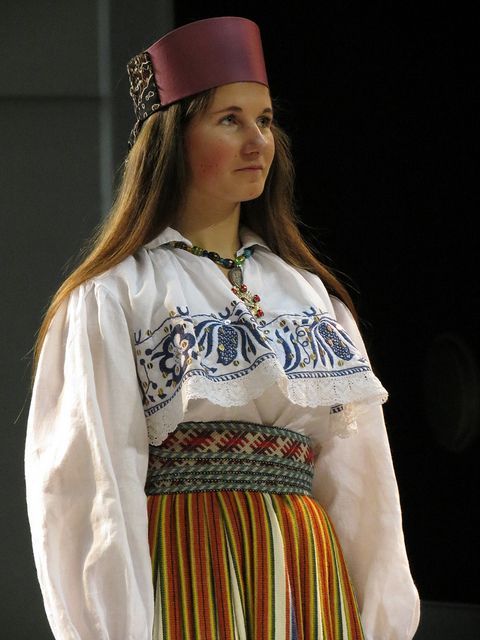
Folk costumes of Harjumaa (North Estonia), St Martin's Day Fair, Nov. 8, 2012 - Priit Halberg
328 notes
·
View notes
Text
huh. hey cool- I learned a new Human Geography thing!

ESTONIA HAS LEGALISED MARRIAGE EQUALITY ❤️🧡💛💚🩵💙💜
#the more you know#human geography#indigenous people#finnic language group#sociology#anthropology#physical geography#national identity#Estonia#Baltic#Nordic
23K notes
·
View notes
Text

All the beautiful Mikus made me go crazy so here is a Livonian (lībiešu) Miku!!! Livs or Livonians were a Balto-Finnic tribe living on the cost of Baltic sea and are one of the ancestors to modern day Latvians:)) I'd fight a feral racoon or maybe even multiple if it meant I could get even a piece of some of these archeological traditional clothes... but I don't think there's racoons in this part of the world. Which sucks for me.
#hatsune miku#miku worldwide#livs#livonians#traditional clothing#small tribes no one gives a shit about but i kinda do :)#my miku def has a little dagger for them haters#let me fight racoons#rady_art
695 notes
·
View notes
Note
Hey, I noticed that in one of your posts you showed an Iron Age Finnish woman's dress. Would you happen to have a good idea of what Finnish men were wearing in that era? The information on it seems sparse. I do have a relevant book that I'm about to look through, but I'd like to hear your insight too!
Hi! Thanks for the question (and sorry for the slow answer), I do love Finnish Iron Age clothing so it's always my pleasure to write about it. I've been wanting to do a deep dive into this for a long while, so maybe I'll do at some point a post about women's dress too.
Unfortunately no one has good idea of the Finnish Iron Age men's dress (and if you find any book or other source that claims otherwise, do not trust it), since there's much fewer archaeological finds of men's dress than women's dress. The most accepted theory on why the textiles of women's dress survived surprisingly well is because of the bronze ornamentation commonly sewn into especially the fine women's dresses of the era. The bronze protected them from decomposing fully. Presumably men's dresses were not decorated similarly then. There are some finds though and we can piece together at least some kind of vague picture.
I will be discussing the period from Viking Age to Crusade Age in Finland. Viking Age is often defined to cover 800s to mid-1000s and the Finnish Crusade Age started right after the Viking Age and ended in the end of 1200s, where the Finnish Medieval era begins. Crusade Age refers to the period where mostly Swedish (also German) crusaders in the span of couple of centuries conquered lands of the Baltic-Finnic pagans. The crusades of this period targeted pagans all over eastern Baltic Sea, including Baltic-Finnic Karelians, Livonians and Estonians, and Baltic peoples, and the Scandinavia too, where Sámi people were targeted. After that the Finland and Sápmi were colonized by Norse people and stayed that way untill Finland was transferred under Russian rule, but to this day Sápmi still stays under colonial rule, including Finnish colonial rule. The current Finland was very multicultural area, mostly populated by Finno-Ugric peoples, including Sámi people, Karelians and various Finnish peoples.
It's important to understand that even just Finnish peoples where not homogeneous, but had distinct, yet of course strongly related cultures. These were Finns (suomalaiset) (yes most people we now call Finns were not in fact called that) in the coast of southwestern and western Finland, Tavastians (hämäläiset) in central-western lake-Finland and Savonians (savolaiset) in central-eastern lake-Finland. This means we can't mix findings from all over Finland to reconstruct a dress without evidencing that all the elements were actually used in one place. These three tribes had broadly similar base for their clothes, but distinctive jewelry and detailing. The big divide was and has always been between eastern and western Finnish peoples. This is because western Finnish people were in close contact through the sea with Norse people and southern Baltic-Finnic peoples, while eastern Finnish people, Savonians mostly, were influenced a lot by their proximity with Karelians. Another dividing factor was the very different environmental conditions between western and eastern Finland. The Finnish coast especially in west is very flat and fertile land, while the lake area, especially in eastern Finland is very rocky, hilly and quite infertile. The main way it effected clothing differences was that western Finland being more wealthy had more elaborate clothing. Tavastians in both occasions fall quite in between, but they tended to be more in the western cultural camp.
My most important sources are a study by a doctor of cultural anthropology, Jenny Kangasvuo, Savon historia I (Savonian history) digitized and open sourced here and the digitized archeological collection of Finnish Heratage Agency. They are all in Finnish so not very useful for most people unfortunately.
Finnish Men's Dress in Viking and Crusader Ages
The basic garments men wore were broadly similar as women. They wore a shift/shirt, knee or above-knee length dress, cloak, belt, shoes and some kind of headwear. Wool was used most commonly, though the shirt would sometimes be linen too. Even evidence of silk has been found in some western Finland graves. I would assume that would be from a dress of some great man, who traveled to gain riches, possibly with vikings. Embroidery and decoration with metals was a typical feature of the whole Eastern Baltic Sea area. In Finland during this period bronze was the most common decorative metal, but silver was used too. Decorative elements were usually woven with small bronze spirals into all kinds of patterns. Here's examples from the reconstructed Ravattula's dress (Finns) used by women.
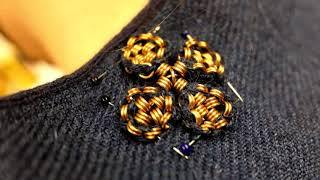
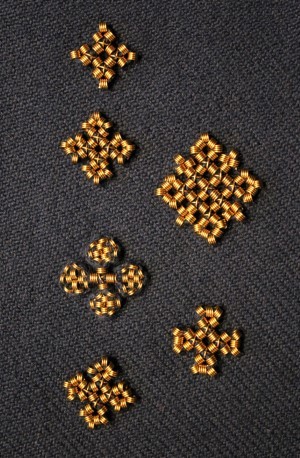
Shirt
The shirt (in Finnish shift of both women and men was called shirt) was basically a long shirt or under dress. We can assume it was similar to those of women's except shorter since the dress men wore was shorter too. They were made from wool or linen, I would assume wool was used in winter and linen in summer, when linen was even available. The neckline had a cut and closed with a bronze brooch. Horseshoe brooch was common. The first one is a quite typical bronze horseshoe brooch with a bit of ornamentation from Salo (Finns). The second one is from Tuukkala, (Savonians), it has exceptional ornate detailing and is uncommonly silver, not bronze. The third picture has two quite uniquely ornamented horseshoe brooches, first from Köyliö (Finns), second from Kurikka (Finns).
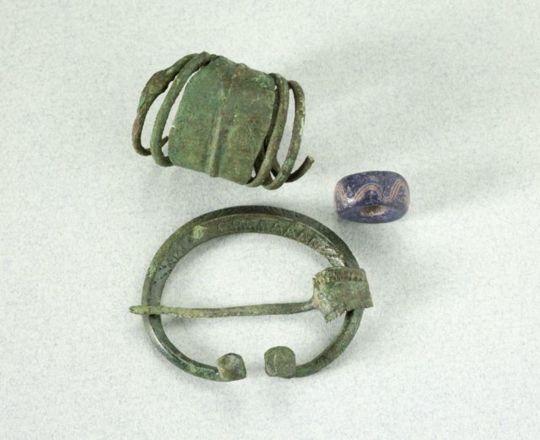
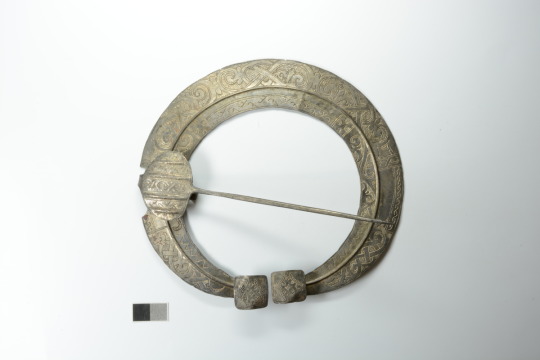
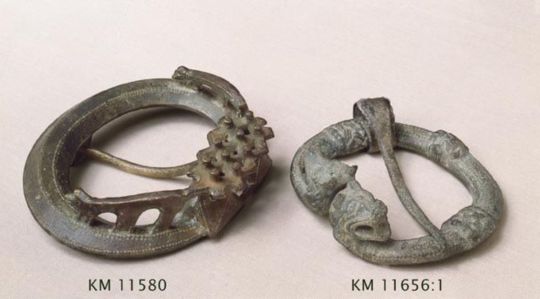
Legwear and footwear
Very little of men's legwear has survived and it's unclear weather men wore pants or separate pant legs, leg wraps or perhaps long socks. Evidence of strings decorated with bronze spirals and tablet woven band has been found in leg area of men's graves. This could mean that they wore either leg wraps, long sock or some sort of pant legs that needed to be secured with string or band under knee. Women used strings and tablet woven tape to secure leg wraps and socks, which I think supports that theory. Sometimes both bronze decorated string and tablet woven band was found in the leg area, which would still be explained by this theory, since it was common to decorate the ends of the bands with bronze decorated strings. Here's an example of sock bands just like that from the earlier mentioned reconstruction of the Ravattula's women's dress. Since men's dress was shorter, I think it would make sense if they still wore some kind of pants or separate pant legs with socks or leg wraps like that.
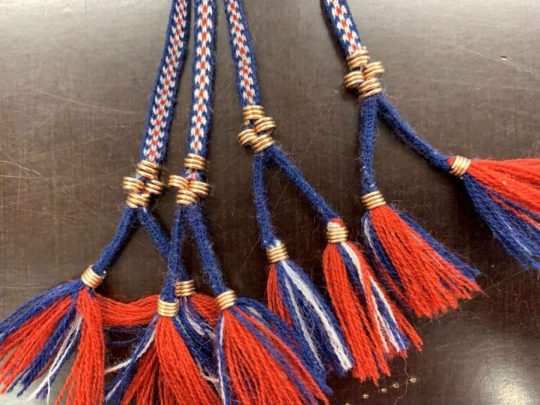
However, the strings and bands could have also been part of the shoes. Everyone probably wore similar shoes - laced leather shoes with a bit of pointed end. They might have been short or ankle length and the lacing was done with either leather cord or tablet woven band, which would also explain the findings. Socks or feet wraps would have been used in them, and straw or wool could be added as filling for warmth. Here's a pair of traditional Izhorian shoes from Estonia from early 1900s, and a pair of traditional Sámi shoes. The designs were likely roughly similar in Viking and Crusader Ages, though obviously more simple, and it's probable that Finnish shoes very something like that too. Here's a 1893 drawing of what findings of shoe material from Korpiselkä (Savonian or Karelian) might have looked like. Considering the quality of archaeology of that time, copious amounts of salt should be applied. And finally as a fourth picture there's reconstruction shoes from Ravattula's dress.


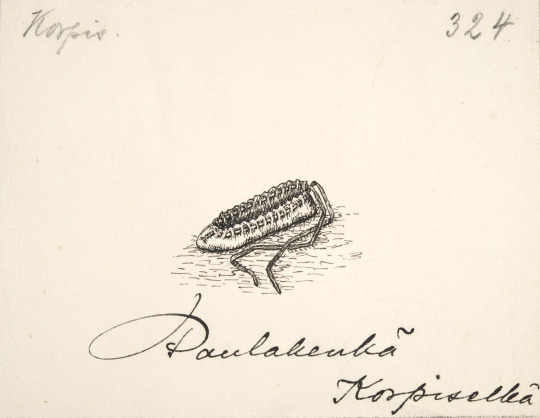
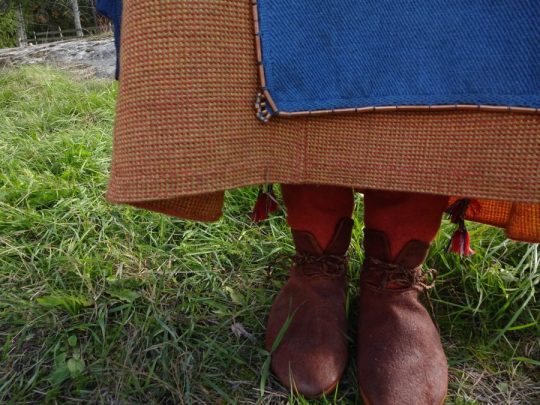
These are not necessarily mutually exclusive theories. The lacing of the shoe could have been laced up the leg and used also to secure either sock or leg wrapping, or they could have been separately secured in ankle and knee respectively.
In some graves twill fabric has been found in the leg area. It could be part of pants or for example leg wrapping, which was often made of twill. One theory about pants is that they were similar as some findings in Sweden, where fairly tight pants made of twill were secured at the hem with buttons similar to cuff studs. These kinds of cuff stud buttons are quite a common find in Finland and some have been found in men's graves close to legs.
Dress
Again there's not much findings of dresses, but a little more perhaps. It was usually from wool. The shape was either a tunic or an open coat. In Karelia there's findings of men's dress suggesting tunics thicker than women's dresses and made from sarka, a type of broadcloth. On the other hand, in Masku (Finns) they found buttons in a row on top of the torso, which suggest a coat closed with buttons. The first picture is a drawing of the grave find. Similary coak closing amounts of buttons have also been found in other places in western Finland. This suggests that Finns and probably Tavastians too wore long coats buttoned to the waist and Savonians wore tunic of Karelian influence. Below there's couple of version of what might this western Finnish men's coat dress could've looked like. The first is an imagined version of the coat based on the Masku grave finds, second is just as imagined version based on Eura (also Finns) grave finds.
Take these "reconstructions" with a strong dose of salt. These are more artistic reconstructions than scientific, since there's not enough material and too much guesswork needs to be done. And because we can see in the Masku grave drawing right here that the other deceased has a large buckle to (probably) close the shirt (to be fair, it could for a cloak too), like was typical, I find it implausible that the coat neckline would be small and round covering the buckle. If you make a decorated big buckle, I assume you want to show it. I would find a v-neckline more probable. It's also easier to make without wasting expensive fabric.
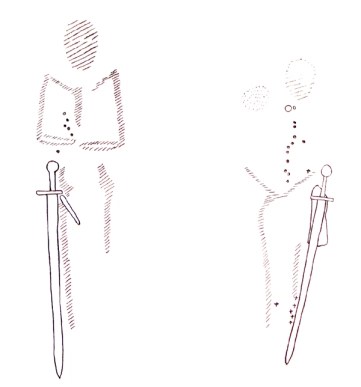
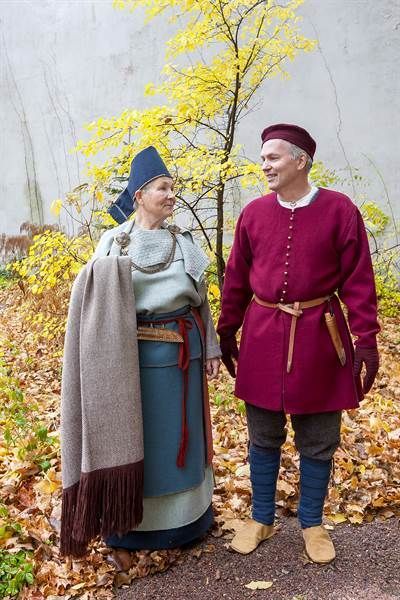
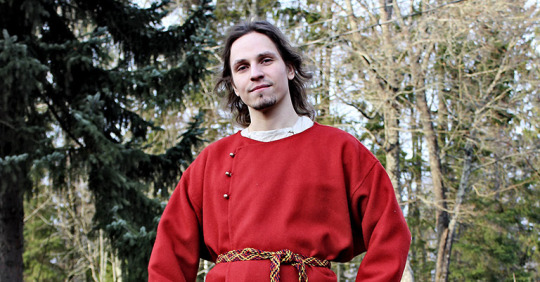
The buttons are interesting. There were what you would imagine - your typical buttons made of bronze like seen in the first artifact from Hattula (Tavastians). But then there was silver jingle bells used as buttons, found for example in both Masku and Eura graves, Eura findings pictured below.
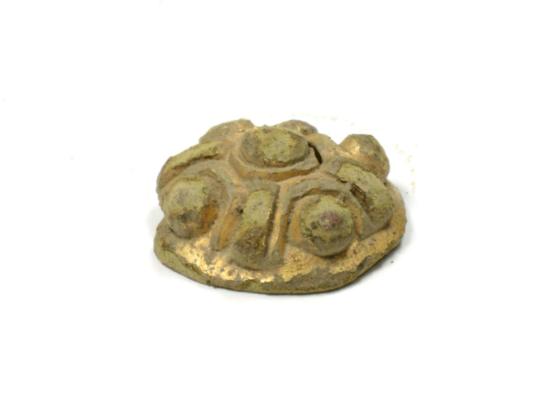
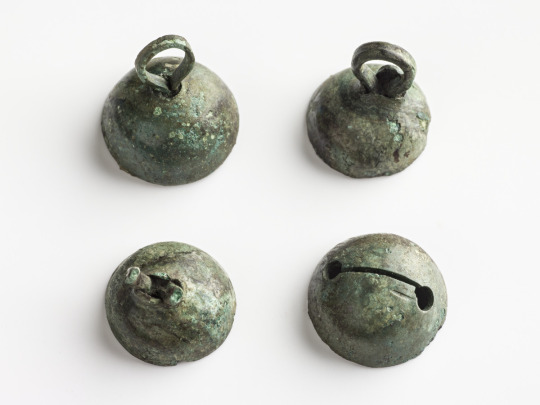
It's possible, even probable I'd say, that the hemlines of men's dresses were finished with tablet weaving patterns, like women's dresses. Also I would assume the pattern of the men's dress (and shirt) was mostly similar to the women's underdress/shirt patterns. So here's couple of different reconstruction patterns for women's dress. Different historians have made different interpretations of the patterns, so it's very much undecided what it really was like.
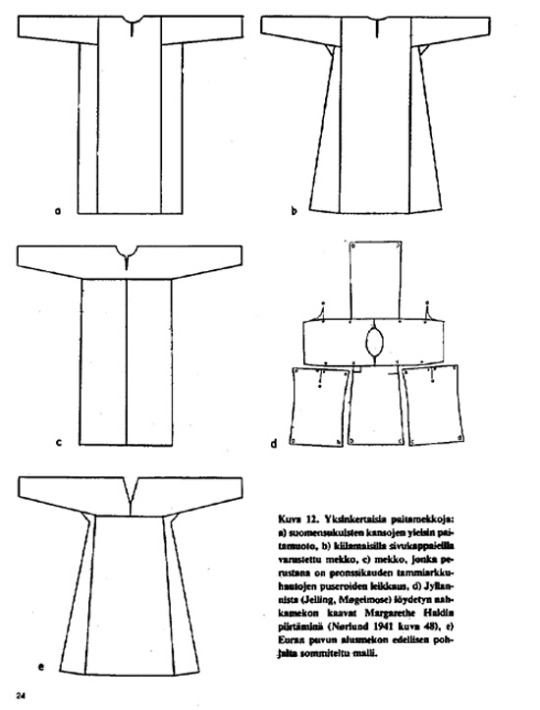
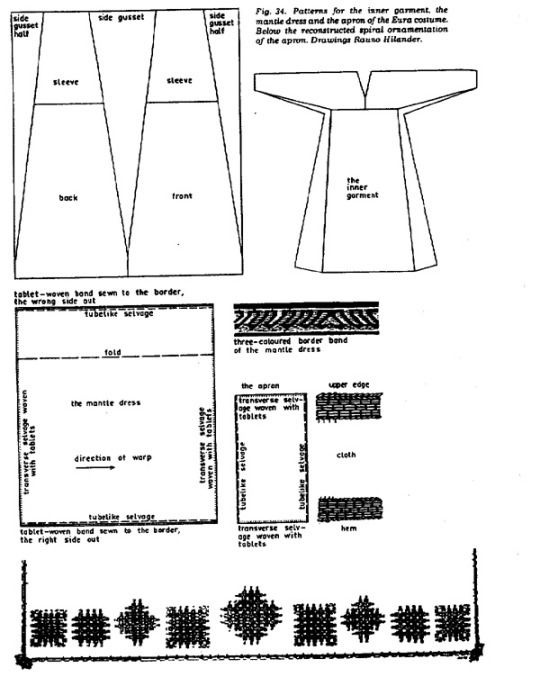
Belt
This is likely the most ornamental part of men's dress. They could be made out of leather or tablet woven band. And there's another east-west cultural divide here. Karelian belts were made out of leather, were usually 1,5-2,5 cm wide, decorated with iron or bronze studs and had a buckle made out of iron or bronze. These types of belts have been found in Savonia too, for example in Tuukkala grave find, which you can find very cool pictures of in this photo documentation of the dig in pages 173-175. In western Finland a "hela" belt was the common style. I don't think there's a world for hela in English. It's a sort of decorative lamella, small metallic plate (not necessarily square but often so) attached to fabric or leather with studs or sewing. Hela belt came from the Permians of Kama river, who were one of the many Finno-Ugric peoples who used to populate much of European side of Russia. Karelians lived closer to Permians, so you might think Permians would influence eastern Finland more, but my theory is that the costal Finns, who frequently joined viking crews and at least were in close contact with merchants including vikings, who would travel along the eastern route through the eastern European rivers, where they could go all the way to Kama river or at least meet traveling Permians. Here's yet another Finnish source more on the Finno-Ugric people around Kama river.
Anyway, hela belt was made of leather and filled with small decorated lamellas, often in square shape, but various other shapes too, like animal ornamentation. In this period hela belt helas were bronze. First image is a nice full set of hela belt metal pieces found in Pirkanmaa (Finns). Second is an older example, right before Viking Era, from Vaasa, costal settlement, (Finns), depicting a very Permian style. The third one is a lion hela found separately in Pälkäne (Tavastians). They are also found in Tuukkala, showing that both eastern and western cultural influences were present there at the same time.

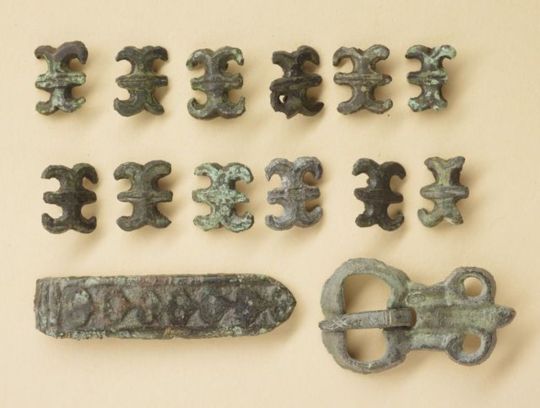
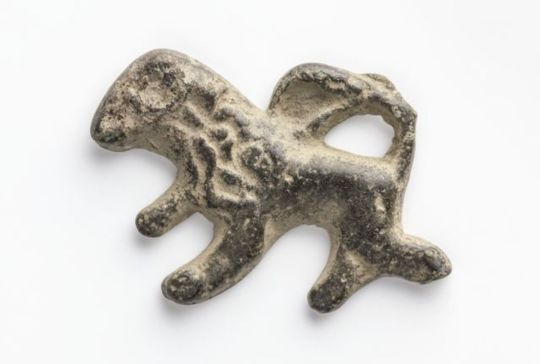
Another western Finnish belt type for men had intricate tassels decorated with bronze spirals hanging on the waist at the end of the belt. They could be made out of leather or tablet woven band. First image depicts a reconstruction of such tassel. Belts in east and west would have strap dividers to hang straps for things like purse, knife and sword. The first picture above has couple of those, but the second picture below has two more of them in more detail in the middle of the picture. These finds are from Lieto (Finns).
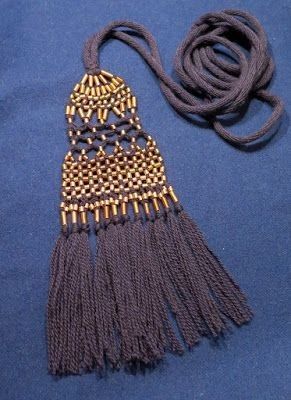

Cloak
Like women's cloak, men's cloak was woolen and either a square or trapezoid. Cloak is yet another east-west divide. In western Finland men's cloaks have embroidery with bronze spirals. They in fact appeared earlier in men's cloaks (in 900s) than in women's cloaks (1100s). They were also a little different in men's cloaks. The spirals and the patterns themselves were bigger and the fastening thread itself was also used for the pattern creation, unlike in women's dresses, where the thread was mostly covered. In eastern Finland there has been no finds of bronze decorations in men's cloaks, mostly only cloak brooches have been left of them. Unsurprisinly same applies to Karelia. This also means there's very little fabric left too. There's one exception. In Tuukkala (Savonians) they found a piece of fabric probably from men's cloak, though it could be from a men's dress too. It was striped, with possibly white or brown base and wide stripes of red, blue and yellow. So perhaps eastern Finnish cloak was not non-decorated, but the decoration was in the fabric pattern. Unfortunately it's hard to know how common fabric like that was, when so little of it is left.
Accessories
It's safe to assume men too wore some type of headwear, but none of those has survived. It probably means it was entirely made out of fabric whatever it was. Some type of hat or cap was certainly used in cold weather at the very least. Tablet woven headband was also possible option for not too cold weather.
In Tuukkala there was couple of interesting jewelry finds too. Two graves had a necklace type mostly found in Karelia. It was birchbark tape covered with nettle fabric and had square helas sewn into it. There were also more typical Finnish necklaces made of beads and bronze spirals.
Razors have also been found with men in their burials, so we can assume shaven faces or at least trimmed beards and moustaces were fashionable.
#dress history#historical fashion#historical clothing#fashion history#history#iron age dress#finnish iron age dress#finnish history#archaeology#answers#anon
224 notes
·
View notes
Text

I know this might not look too flashy, but this might be my favourite stamp sheet. These Estonian stamps are a language tree of the Uralic languages.
Going anti-clockwise from the bottom middle stamp, we have:
The Samoyedic Languages: Nenets, Enets, Nganasan, Selkup, and Kamasin
The Ugric Languages: Hungarian, Khanty and Mansi
The Permic Languages: Komi and Udmurt
The Mari and Mordvinic (Erzya and Moksha) Languages
The Sami Languages (Nortern, Southern, Skolt, Inari, Lule, Ume, Pite, Ter and Kildin Sami)
The Baltic-Finnic Languages: Veps, Karelian, Izhorian, Livonian, Finnish, Estonian and Votic
Languages in brackets weren't mentioned in the stamp, but I thought I'd elaborate anyway
Edit: put Ingrian instead of Izhorian. Should've known better, sorry
#philately#stamp collecting#stamps#estonia#eesti#uralic#uralic languages#nenets#enets#nganasan#selkup#kamasin#hungarian#khanty#mansi#komi#udmurt#mari#erzya#moksha#sami#saami#veps#karelian#livonian#finnish#estonian#votic#Izhorian
80 notes
·
View notes
Text

Legends and myths about trees
Legendary tree deities (23)
Metsaema – the mother spirit of the forest in Estonian mythology.
The name Metsaema translates to "forest mother" in Estonian (from metsa "forest" and ema "mother"). For this reason, the word metsaema can also be used as a descriptor of other similar deities in Eastern European mythology, for example Vir'ava.
The mother of the forest acts as ruler and guardian. She is sometimes also connected with fertility, acting as a midwife in some texts. Forest spirits are said to be found in each forest, ruling over the animals, birds, trees, and berries. Wild animals such as bears, snakes and wolves are commonly connected with them across European mythologies.
The shared elements of Finnic, Slavic, Baltic and Turkic mythology can be seen in similarities between forest mother spirits. Metsaema has strong similarities with the forest mother spirits Vir'ava, from Mordven mythology, and Meža mate, from Latvian mythology. Other related deities are the Lithuanian goddess of the forest and animals, Medeina, and the Finnish goddess of the forest, Mielikki (Ref).
[Photo below: European pine marten ]
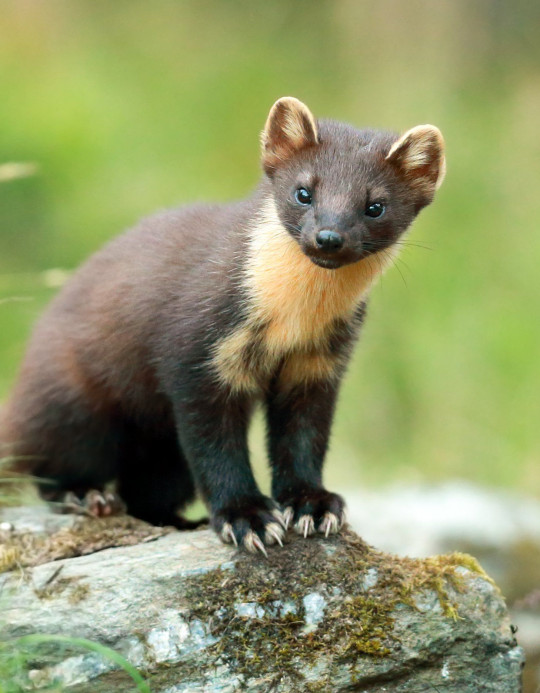
木にまつわる伝説・神話
伝説の樹木の神々 (23)
メッツァエマ 〜 エストニア神話に登場する森の母なる精霊
メッツァエマという名前は、エストニア語で「森の母」と訳される(メッツァは「森」とエマは「母」の意)。このため、メッツァエマという言葉は、例えばヴィラーヴァのような、東欧神話に登場する他の類似した神々を表す言葉としても使われる。
森の母は支配者であり守護者である。彼女は時に豊穣にも関係し、助産婦のような役割を果たすくだりもある。森の精霊はそれぞれの森に存在し、動物、鳥、木、木の実を支配していると言われている。熊、蛇、狼などの野生動物は、ヨーロッパの神話に共通する。
フィンランド神話、スラブ神話、バルト神話、テュルク神話に共通する要素は、森の母なる精霊の類似性に見ることができる。メッツァエマはモルドヴェン神話の森の母なる精霊ヴィラーヴァやラトヴィア神話のメジ��・マテと強い類似性がある。他にも、リトアニアの森と動物の女神メデイナや、フィンランドの森の女神ミエリッキ(参照)が関連している。
#trees#tree myth#tree legend#Metsaema#folklore#mythology#legend#estonian mythology#forest mother#forest#european pine marten#forest spirit#nature#art
147 notes
·
View notes
Text
Some etymologies of Finnish foodstuffs
Peruna - Potato From late old Swedish pærun (pear). Potatoes were first called “maaperuna” (land pear). Today, “pear” is “päärynä” from the same root. Voi - Butter From proto-finno-ugric *waje. Some relatives include Hungarian vaj and Northern Sami vuodja. Hunaja - Honey From old proto-germanic *hunagą (Same root as English “honey”) Porkkana - Carrot From Russian борка́н (borkán). It is also present in many Baltic languages and the ultimate source is unknown. Kala - Fish From proto-uralic *kala. Some relatives include Hungarian hal and Northern Sami guolli. Sipuli - Onion From late old Swedish sipul, ultimately from late Latin cepulla. Related to the obsolete English onion name cibol/chibol. Vesi - Water From proto-Uralic *wete. (May be further related to Proto-Indo-European *wódr̥). Some relatives include Hungarian víz. Suola - Salt From proto-Finnic *soola, ultimately from Proto-Indo-European *séh₂ls. Related to English Salt. Sokeri - Sugar From Swedish socker, ultimately from Sanskrit शर्करा • (śárkarā) and probably others

#finnish#langblr#langblog#language#beginner finnish#suomen kieli#finnish language#finnish langblr#etymology
75 notes
·
View notes
Text
Unknown ancient languages in the area of modern day Finland
Before the arrival of Western Uralic languages, which eventually developed into the Sámi languages and Finnish, there were already earlier languages being spoken in the area of modern day Finland. These ancient languages are completely unknown to us; after all, their cultures did not write. However, some names and words from those languages still live on as they were loaned into Sámi and Finnish and are still in use.
The prevalence of these loan words is higher in Sámi than in Finnish: as much as third of the words in Sámi languages are of unknown origin. The Sámi linguist Ante Aikio has been able to find at least two different ancient languages which the Sámi languages loaned words from in the area. The southern language he has dubbed Paleo-Lakelandic, the northern one Paleo-Laplandic. Before the arrival of Western Uralic languages, there had already been human settlements in Finland for nearly 10 millenia.
The first wave of Western Uralic languages came from the group whose Western Uralic dialect eventually developed into the Proto-Sámic language. As established, they loaned a lot of words from these ancient languages in Finland. The Finnish language has a more complicated origin, geographically. I'll write it with a smaller font as it is kind of off-topic but if you're interested:
The sister of Proto-Sámic is Proto-Baltic Finnic, which was born when Western Uralic dialects west of modern day Central Russia split into Proto-Finnic and Mordvinic lanugages. At this state, they loaned words from the ancient language of the Comb-Ceramic culture. Some of Proto-Finnics started living together with the Indo-European Baltic speakers, resulting in the birth of the Proto-Baltic Finnic language. This community was bilingual; possibly even for a thousand years. This explains the massive amount of Baltic loan words in Finnish. This community also loaned words from the earlier languages of the Baltic (before the arrival of Baltic or Proto-Baltic Finnic languages), mainly names of different kinds of fish.
After this, the Proto-Baltic Finnic language spread over the gulf to Southern Finland and encountered ancient languages of Finland it borrowed words from. Eventually, it encountered (and mixed with) Proto-Sámic. This mixing resulted in the birth of Finnish (or rather, its different dialects) as its separate language. Similarly, in the more northern areas, the Proto-Sámic language split into the different Sámi languages of modern day.
This process was slow. In the 17th century, there were still the last speakers of a Sámi language in Kainuu, for example. However, they mixed with and switched to Finnish centuries ago. And similarly, there were possibly still pre-Sámi languages spoken in the north of Fennoscandia during the Medieval times. They switched to speaking Sámi, much like Sámi-speakers in more southern areas switched to speaking Finnish.
Some words (note these are educated guesses):
The words "kontio" (bear) and "nuotio" (campfire) possibly came to Finnish through Sámi, originally from Old Lakelandic. Also through Sámi, from Old Laplandic, are the words "mursu" (walrus), "norppa" (ringed seal), and "kiiruna" (rock ptarmigan).
Some words that were loaned from ancient languages directly to Proto-Finnish without the Sámi middleman include "niemi" (small peninsula), "saari" (island), and "vuori" (mountain, hill).
Many place names in Finland have names that seem to originate from ancient languages as well, such as Saimaa, Inari and Päijänne.
The text is translated and condensed from Ennen suomea ja saamea Suomen alueella puhuttiin lukuisia kadonneita kieliä — kielitieteilijät ovat löytäneet niistä jäänteitä (Prior to Finnish and Sámi, multiple lost languages were spoken in the area of Finland — linguists have found relicts of them).
17 notes
·
View notes
Text
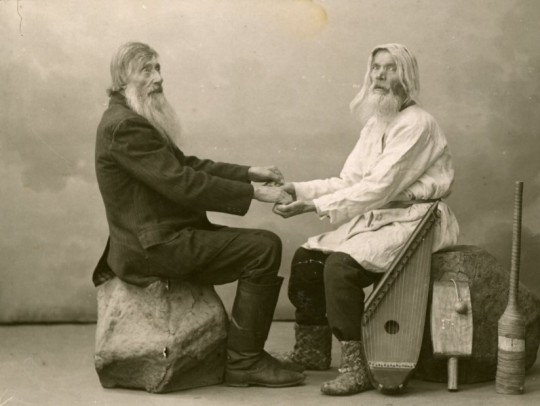
Rune singers Iivana Onoila and Jelisei Valakainen in Terijoki, 1911.
Runesong is a genre of folk music, or a form of oral poetry, historically practiced among the Baltic Finnic peoples. Originating in the Finno-Ugric belt from the Urals (Russia) to Finnskogen (Parts of eastern Norway and Sweden). With the oldest songs being over 4000 years old, the runesong often has a religious content, partly incantatory, but can also have a historical summary content with myths. Some of the incantations were linked to the desire for protection and healing, i.e. the medical rune chants.
#upload#runesong#finnic peoples#finno ugric#forest finns#finnskogen#1900s#1911#rune singers#history#nordic history#tried to summarise it as good as i can most info being from wiki#and photographer is unknown
21 notes
·
View notes
Text
they always sayin "sail high!" but when i commandeer the helsinki-tallinn cruiseferry while gone off that loud to become a baltic pirate n find the deep sea cryptid known in old finnic legends as iku-turso suddenly i'm "wanted by NATO"?????
7 notes
·
View notes
Text



I've been thinking about Golden Maiden, Silver Bride last couple of days, so I made the central characters in this picrew!
Miävi (MC)
she's basically a magic robot made out of silver and gold
she was created couple of years ago and her body was made to be adult's body in shape but because she's not human with human brain that needs development, in her behavior and understanding she's basically a teenager/pre-teen, though of course she has less life experience than a human teenager
she's sort of a mix of veere (a sort of demigod, who are kinda distantly like elves (though based on Baltic Finnic mythology's Kalevanpojat/Kalevipoeg)) and mountain elf of metals, since she's made of metal and a part of the soul of her creator, Tyynövin, who is veere
she's based on the mythical figure Kultaneito (Golden Maiden) from Baltic Finnic mythology
she's very sheltered and a people pleaser and extremely repressed (has some anger issues buried deep into that repression)
Tyynövin made her to be his perfect bride, but she was not and he planned on murdering dismantling her, so she escaped
Tiera
Miävi's guard and father figure
human
he was extremely devoted to Tyynövin, but he became attached to Miävi and when Tyynövin was about to kill her, he choose her over his loyalty and helped her escape
Tyynövin's magic was keeping a curse from spreading in his body though, so when he is on the run with Miävi, the curse slowly destroys his body
he's quiet, not great in social situations and looks always angry, but is also very caring
extremely divorced even though he is actually still married
he's extremely lightly based on the mythological side character of the same name from Baltic Finnic mythology
(in the myths he's a brother in arms to Lemminkäinen and because he's so eager to get to war he doesn't consummate his marriage with his newlywed wife, and with the homoerotism inherent to all-male armies I could only think there's no heterosexual explanation for this, and I knew I needed to make a character out of it)
Vanaróu (Vaan)
he's a veere from Caie's clan
his character is also lightly based on the tragic hero Kullervo from Baltic Finnic mythology
Tyynövin is from the Urva's clan, who massacred the Caie's clan, which only Vaan survived, so in vengeance he killed Tyynövi's wife, which is why Tyynövin tried and failed to replace her with Miävi
Vaan lives with humans who try to stay independent from the Urva empire
he has a bloodthirsty talking sword and regenerative magic that heals his wounds
he's a certified himbo, but also has a violently angry side, though he rarely let's it be seen
GMSB tag list: @siarven @worldbuildng @outpost51 @faelanvance
Let me know if you want to be added or removed!
I hope I didn't miss anyone since I seemed to have lost the tag list i made for GMSB, so I went through my posts where people might have asked to be added to this. If I didn't tag you and you had asked to be tagged earlier, please let me know and I'm very sorry :D
#writing#my writing#writeblr#fantasy#am writing#my wips#original character#my ocs#mythology retelling#retelling#dark fantasy#original fiction#gmsb
42 notes
·
View notes
Text
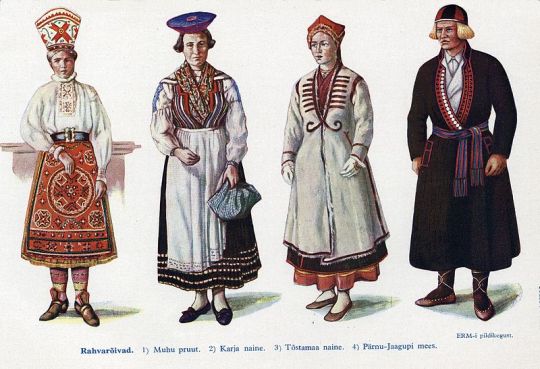

Estonian Folk Costumes
118 notes
·
View notes
Note
I would like to know more about the fish in your profile pic. :)
oh!!! of course!!! gladly :) here's a full picture of the little fella:
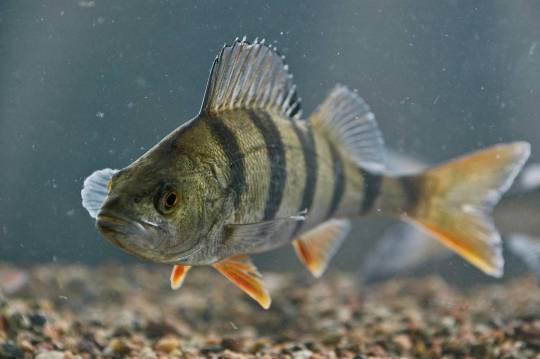
so this guy's a Perca fluviatilis, or European perch, or just a perch, or in Finnish, ahven!
It's a predatory fish that lives in both fresh and brackish water, so here in Finland, dotted with over 180 000 lakes (albeit most are very small) and surrounded by the brackish waters of the Baltic Sea (or Itämeri in Finnish, which is funny because it means the East Sea even though from Finland said sea is to the west, but it's a direct translation from Swedish, to whom it is in the east lol anyway), it's a very common fish. In fact, it's the most common fish in Finland! There are a lot of little lakes and ponds in which it might be the only fish. It's also the national fish of Finland!
The important characteristics are the red (or really orange usually) fins and tail, the darker stripes, and the spikey dorsal fin, with the little black dot at the end towards the tail. In some of the darkwater lakes they can get almost black, though, so the stripes aren't always visible, but for example in the sea, where the water is clearer, you can see them well.
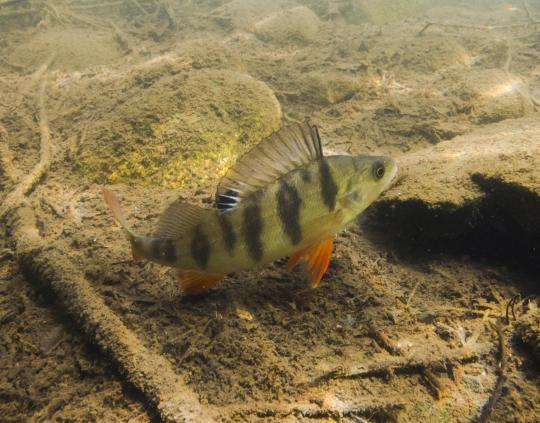
They can grow pretty big, but are usually 15-30 cm and weigh at most something like 350 grams, though occasionally bigger fish are found. When it comes to people who fish for fun, and not like, with big ships, the perch is the most commonly fished fish in Finland, I think? They can also withstand waters quite a lot acidic than most Finnish fish, which contributes to them living in tiny bog ponds as the only fish in there. Mostly they live in Europe (aside from Spain and Italy) and all the way to the Kolyma River in the Russian far east, but they've been planted in places such as Australia, New Zealand/Aotearoa, South Africa and even China I think? Where they're endangering the native fish species :[ so that's not good
They're pretty curious little fishies! They live in schools of fish during the day and look for food together, but at night they rest on their own at the bottom of the body of water they live in. A few times, when I've gone swimming in a lake with clear water, I've spotted them in the shallow water rather close to people swimming, and when I stayed in place for long enough they came really close a few times! I could've almost touched them, but they're also really fast, so they would've (and probably did) sprint away.
I've caught them a few times, but the ones I've fished have been too small so I've let them go. When my dad's side of the family used to have the cottage in the archipelago my mom has now, my grandparents used to put out the fishing nets (I helped a few times as well!) and then in the morning I'd help take the fishes out of the net, and there'd be perch there pretty often. I've also filleted these fish, and eaten them haha. My favorite is perch covered in flour and fried in butter, served with mashed potato! But most of all I do like just watching them :)

A couple more fun facts! They have a sharp boney spike at the edge of their gill cover, so you have to be careful when you hold them for example taking it off a hook! And the spikes on their back! They're very spiky fish :D
The word for ahven here in Russian is окунь, okun', which according to a version of the etymology, comes from the old word for eye, oko. In Finnish, ahven is pretty close to the reconstructed Proto-Finnic form *ahvën, but we don't know what the etymology for that is! The name for the fish is really similar in most Finnic languages though:

Lastly, the Finnish name for the big island and autonomous region of Åland is Ahvenanmaa, with ahvena being a dialectal form of ahven, and thus the name is like, the land of the perch :) It might come from the fact that in the 1500s, the people from there paid their taxes in perch? The etymology on that one is a little unlcear still! Just a fun little fact. :)
Here's a picture of a little ahven I took in 2018!
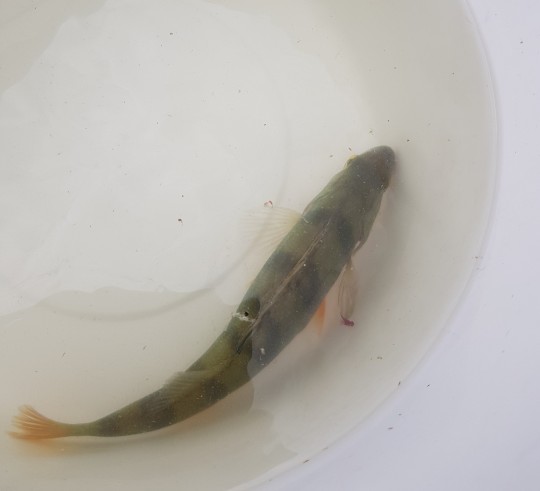
I just really like them :) ahven my beloved <3 <3 <3
#thank you for the ask!! :)#if you see a post on tunglr with ahven in it: PLEASE tag me i woudl love to see it
25 notes
·
View notes
Note
geopolitically estonia is baltic, the estonian language is ugro-finnic; estonia isnt recognized as nordic by anyone, the tweet op probably called them that bc theyre in the north or something, or maybe bc of their bonds with finland
Ooh, thanks for the clarification and information!!
#estonia#i didnt know the language was that. very cool#i thought at first i was supposed to read it like they joined the nordic nations in legalizing gay marriage but then reread it#anon
34 notes
·
View notes
Text
Have a mangled Baltic Finnic rune-song :')
Rider through the waves,
Traveler through the foam,
Goer through shaft bows
Nixie your name
Son of bittercress
Four-leg's fetus,
Supported by bipeds,
Revealed by Man,
Get to know your work,
Come to cure your evil!
You did well when you did ill,
You do better when you heal.
Drink your ills as wine,
Your own evils as beer,
Into your brassy belly,
Into your golden dome!
3 notes
·
View notes